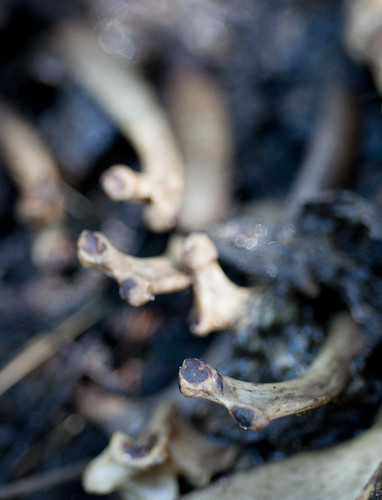Sadly, there are irresponsible dog owners in the area, who do not believe in leashing their pets. Even worse, some folks simply let their dogs wander through the neighborhood, unattended, to do whatever they please, wherever they please. Unattended dogs often end up in our yard, sometimes just to defecate, and other times, to investigate the coyote. It's not something I'm happy about, and I wish more could be done to enforce the leash law.
A week or so ago, I went out back to survey our yard, and when I got to where the coyote should have been, it was entirely absent (despite having been there perhaps an hour before). I was both alarmed and concerned, and set out at once to locate it – surely a dog couldn't have dragged the whole body away without anyone noticing. It didn't take me long to find it: the coyote rested in a nearby driveway, about thirty feet from where it was supposed to be. Mostly bones, it was still held together by scant flesh, and I returned the carcass to our backyard. One of the back legs, however, was missing, and I doubt I'll ever see it again.
Not wanting a repeat of this incident, I placed a pallet, lined with window screening, over the body. This worked for a few days, until I saw that, yet again, a dog had visited, and had attempted to pull the coyote out from under the pallet. This time, it had made off with half of the pelvis and several tail vertebrae, which I'm sure are now long-gone. From four planks of wood and window screening, I constructed a more suitable decay-box; however, I had to pull the carcass apart, into four separate pieces, for it to fit underneath. On top of the decay-box I placed two heavy rocks. So far, this has worked.
This is what the coyote looked like this morning, after two days in a row of rain:
Predictably, the carcass is soggy and stinky, but these are great conditions for decomposition! Note the coyote's ghoulish, semi-mummified eye.
Ribs poke through decomposing flesh, catching the sunlight. I cannot stress enough how crucial this rain has been; the Upper Peninsula has been in a state of drought for years and years, and this particular spring has already been brutal. Last week there were two very large forest fires east of here, which together burned up tens of thousands of acres. Both are contained or near containment, and I'm sure the rain helped. Rain: good for plants, good for soil, and good for decomposition. All of these things are interconnected.
The right side of the coyote's head was damaged when she was hit by a car, and I have a feeling it was the impact against the pavement that did it. A few of her teeth are shattered, as is the back of her cranium. I look forward to seeing the skull in full, once the decay has finally finished.
Note: Had a wild animal dragged the coyote away, I would be disappointed, but not angry. Scavenging is part of the natural world, and is, obviously, an integral part of this project's message. However, domestic dogs are not wildlife, nor do they belong in my backyard, so I do believe my exasperation and call for dog owners to leash their pets are justified.
Another thing of note: In the winter, when the coyote carcass had flesh on it, it was visited by foxes, raccoons, and quite possibly a mink. The body wasn't once disturbed by dogs, as people don't typically let their dogs out for extended periods of time when it's cold. In contrast, when the flesh truly started to decay past the stage of edibility, wild animals left the coyote alone entirely.







No comments:
Post a Comment